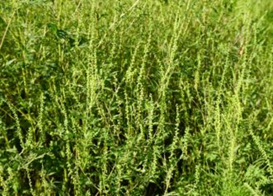Conservation Corner
Conservation Corner is a weekly article produced by the Forest County Land &Water Conservation Department. For more information contact Steve Kircher, County Conservationist-Land Information/GIS Director at 715-478-1387 or by e-mail at .
This time of year, many of you may be sneezing and suffering with allergies. I bet many of you are blaming Goldenrod for your watery eyes and runny noses. Many people suffer from allergies in mid- to late-summer, but few know exactly what causes them.
Goldenrod, a common flowering plant with masses of golden flowers, is often blamed for the itchy eyes, runny nose, and other symptoms that many of us suffer from during summer allergy season. However, for most of us, ragweed pollen is the true culprit. While goldenrod actually benefits butterflies, bees and other pollinators.
Ragweed is the big contributor to allergy season. (In short, goldenrod’s pollen is too large to fall far from the plant, but ragweed’s tiny, light pollen travels widely.) Still, goldenrod continues to get a bad rap.
Both plants are members of the Asteraceae family, grow in roadside ditches and open fields, and bloom at the same time.
Goldenrod flowers contain nectar to attract pollinating insects, and the large, heavy pollen grains attach to the insect bodies. It is an important nectar source for pollinators. Ragweed flowers do not contain nectar, and the plants are dependent on the wind to transfer the small, lightweight pollen. This pollen has the ability to blow for miles.
 A single ragweed plant is capable of over a billion pollen grains. The next time you think it’s the beautiful goldenrod causing your allergy woes, think again.
A single ragweed plant is capable of over a billion pollen grains. The next time you think it’s the beautiful goldenrod causing your allergy woes, think again.
RAGWEED
Goldenrod has a reputation as an invasive plant, which can be true depending on the habitat and the circumstance. It’s a common native species that provides a great late-season resource for pollinators.
Goldenrod it can be spread quite rapidly; so much so that it can crowd out other native prairie and savanna species to form a monoculture, creating a field of only goldenrod plants.
This is especially true when there’s a lack of management or an abundance of resources, including space or nutrients. However, with proper management, goldenrod can be an important part of our natural areas.
So just remember that these yellow flowers you see across urban, suburban, rural and natural landscapes are great plants for pollinators, and aren’t likely contributing to your allergies or your neighbors’.

